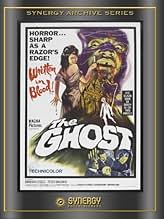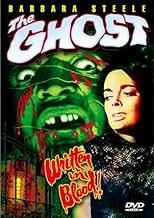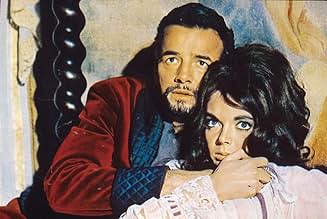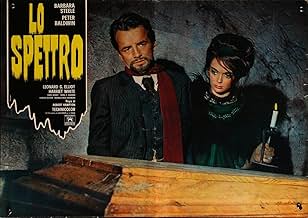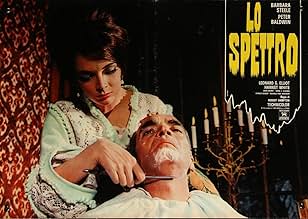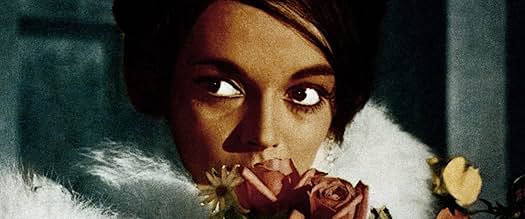IMDb RATING
6.1/10
1.6K
YOUR RATING
A woman and her lover murder her doctor husband, but when strange things start happening, they wonder if they really killed him, or if he has come back from the dead to haunt them.A woman and her lover murder her doctor husband, but when strange things start happening, they wonder if they really killed him, or if he has come back from the dead to haunt them.A woman and her lover murder her doctor husband, but when strange things start happening, they wonder if they really killed him, or if he has come back from the dead to haunt them.
- Awards
- 1 nomination total
Elio Jotta
- Dr. John Hichcock
- (as Leonard G. Elliot)
Harriet Medin
- Catherine Wood - Housekeeper
- (as Harriet White)
Carlo Kechler
- Police Superintendent
- (as Charles Kechler)
Umberto Raho
- Canon Owens
- (as Raoul H. Newman)
Featured reviews
This highly-regarded example of the Italian Gothic Horror style had eluded me until now; even so, having caught up with it at long last, I still wasn't done with the 'Curse Of THE GHOST': the Retromedia DVD proved faulty, with a glitch around the one-hour mark (where the image skipped and the audio dropped out) and then experienced complete freezing after 88 minutes - so much so that I had to finish the film off on another player! This was after a public domain copy I rented from Hollywood when I was there in late 2005 (which, on a hunch, I decided to check before watching) reverted to the Main Menu midway through the climax!!
Anyway, the film itself is undeniably a highlight of the genre and one of Freda's best (which he made in just 12 days): a follow-up, not a sequel, to his previous collaboration with star Barbara Steele - THE HORRIBLE DR. HICHCOCK (1962) - despite the re-use of that notorious character's surname. In the earlier film, too, Steele had been overshadowed by a delightfully manic turn from Robert Flemyng but, here, she lives up to her iconic status as the Queen Of Gothic Horror: few actresses have managed to replicate her sensual mix of wickedness and vulnerability; as for the actor playing Hichcock this time around, who looks a bit like Howard Vernon, he's not too bad - if no match, ultimately, for Flemyng.
Like I said with respect to Hammer's FEAR IN THE NIGHT (1972), the plot twists aren't very original - but they make for a great ride regardless; besides, one could just soak in the colorful visuals (even if the print involved features a lot of wear and tear!). Incidentally, the film is rather gory for its time (witness the 'ghost' exhibiting its decaying flesh and the brutal razor murder, with its wonderful device of having blood dripping across the camera lens to simulate the victim's POV), but the lush score (actually a collection of compositions by Francesco De Masi, Franco Mannino and Roman Vlad - billed under one Americanized name, Franck Wallace!) and a reasonable quota of chills (the creepy scenes where the doctor speaks through his faithful and vaguely sinister housekeeper - played by the ubiquitous Harriet White Medin - who, conveniently, doubles as a medium and the various 'apparitions' - wheelchair stumbling down the stairs, dangling corpse) are certainly par for the course...as is, after all, the film's decidedly languid pace.
The deftly ironic climax is very effective - as a self-satisfied Hichcock expounds on his clever machinations while the immobilized Steele looks horridly on, fully knowing that she'll be blamed for the housekeeper's death and, worse still, that she killed her lover for no reason (i.e. he didn't betray her by stealing the jewels, as she had mistakenly assumed, and these were now once more in Hichcock's hands). The English dubbing isn't too bad considering; however, given the story's Scottish setting, it's odd that only one voice actor would deem it fit to attempt a pertinent accent (i.e. the solicitor who reads Dr. Hichcock's will) - which then causes it to seem unintentionally amusing alongside the less heavy inflections of his fellow dubbing artists!
While Freda is often accused of being indifferent to his films (which he often did purely so as to recoup his gambling losses!), he was undoubtedly a pioneer: not only making the first Italian horror effort, but his masterful use of color in the Dr. Hichcock pictures certainly pushed the genre into that corner - after a solitary stab at it by Giorgio Ferroni in MILL OF THE STONE WOMEN (1960) - as few gothics were shot in black-and-white thereafter (notably three films featuring Steele herself, namely CASTLE OF BLOOD [1964], THE LONG HAIR OF DEATH [1964] and NIGHTMARE CASTLE aka THE FACELESS MONSTER [1965]); certainly, Freda's protégé Mario Bava followed his example...and gradually took over the genre!
Anyway, the film itself is undeniably a highlight of the genre and one of Freda's best (which he made in just 12 days): a follow-up, not a sequel, to his previous collaboration with star Barbara Steele - THE HORRIBLE DR. HICHCOCK (1962) - despite the re-use of that notorious character's surname. In the earlier film, too, Steele had been overshadowed by a delightfully manic turn from Robert Flemyng but, here, she lives up to her iconic status as the Queen Of Gothic Horror: few actresses have managed to replicate her sensual mix of wickedness and vulnerability; as for the actor playing Hichcock this time around, who looks a bit like Howard Vernon, he's not too bad - if no match, ultimately, for Flemyng.
Like I said with respect to Hammer's FEAR IN THE NIGHT (1972), the plot twists aren't very original - but they make for a great ride regardless; besides, one could just soak in the colorful visuals (even if the print involved features a lot of wear and tear!). Incidentally, the film is rather gory for its time (witness the 'ghost' exhibiting its decaying flesh and the brutal razor murder, with its wonderful device of having blood dripping across the camera lens to simulate the victim's POV), but the lush score (actually a collection of compositions by Francesco De Masi, Franco Mannino and Roman Vlad - billed under one Americanized name, Franck Wallace!) and a reasonable quota of chills (the creepy scenes where the doctor speaks through his faithful and vaguely sinister housekeeper - played by the ubiquitous Harriet White Medin - who, conveniently, doubles as a medium and the various 'apparitions' - wheelchair stumbling down the stairs, dangling corpse) are certainly par for the course...as is, after all, the film's decidedly languid pace.
The deftly ironic climax is very effective - as a self-satisfied Hichcock expounds on his clever machinations while the immobilized Steele looks horridly on, fully knowing that she'll be blamed for the housekeeper's death and, worse still, that she killed her lover for no reason (i.e. he didn't betray her by stealing the jewels, as she had mistakenly assumed, and these were now once more in Hichcock's hands). The English dubbing isn't too bad considering; however, given the story's Scottish setting, it's odd that only one voice actor would deem it fit to attempt a pertinent accent (i.e. the solicitor who reads Dr. Hichcock's will) - which then causes it to seem unintentionally amusing alongside the less heavy inflections of his fellow dubbing artists!
While Freda is often accused of being indifferent to his films (which he often did purely so as to recoup his gambling losses!), he was undoubtedly a pioneer: not only making the first Italian horror effort, but his masterful use of color in the Dr. Hichcock pictures certainly pushed the genre into that corner - after a solitary stab at it by Giorgio Ferroni in MILL OF THE STONE WOMEN (1960) - as few gothics were shot in black-and-white thereafter (notably three films featuring Steele herself, namely CASTLE OF BLOOD [1964], THE LONG HAIR OF DEATH [1964] and NIGHTMARE CASTLE aka THE FACELESS MONSTER [1965]); certainly, Freda's protégé Mario Bava followed his example...and gradually took over the genre!
Riccardo Freda's "Lo Spettro" aka. "The Ghost" of 1963 is yet another delightfully uncanny Italian Gothic Horror film starring the wonderful Barbara Steele (my favorite actress), and while it cannot possibly compare to the absolute highlights in Steele's career, such as Mario Bava's masterpiece "La Maschera Del Demonio" ("Black Sunday", 1960), Roger Corman's "Pit and the Pendulum" (1961, also starring the great Vincent Price) or Antonio Margheriti's "Danza Macabra" ("Castle of Blood", 1964), this is another mesmerizing experience that no lover of Gothic greatness can afford to miss. "Lo Spettro" is a sequel to Freda's earlier Gothic Horror film, "L'Orribile Segreto Del Dr. Hichcock" ("The Horrible Dr. Hitchcock", 1962; they obviously left out a "t" in order to avoid legal difficulties), also starring Steele, which I haven't yet seen. Her character is named 'Margaret' in this film whereas the name was 'Cynthia' in "Dr. Hichcock. This film doesn't require having seen "Dr. Hichcock" , however.
Scotland, 1910: The brilliant, but critically ill, wheelchair-bound Dr. Hichcock (Elio Jotta), who needs to take lots of medications against his mysterious disease, is working on a serum to cure paralysis. His beautiful young wife Margaret (Barbara Steele) is having an affair with his assistant/colleague Dr. Livingstone (Peter Baldwin), however, and the two do not intend to wait for the old Doctor to pass away by natural reasons. Shortly after his funeral, creepy things begin to happen in the uncanny mansion...
As mentioned above, the ravishing Barbara Steele, is my favorite actress, and she is once again great here. In my humble opinion, no other actress was ever capable of blending incomparable beauty with a genius for the uncanny as it is the case with this unchallenged Goddess of Gothic Horror, and no other actress ever will. Under the solid direction of Riccardo Freda, Miss Steele plays yet another typical role with typical greatness. As the credited director of the first (post-WW2) Italian Horror film, "I Vampiri" of 1957, Freda deserves praise as one of the pioneers of Italian Horror, though it must be said that it was actually the great Mario Bava (my choice for the greatest Horror director of all-time) who completed that gem and who is arguably responsible for its greatness. Besides our beloved Barbara, the rest of the cast is also very good, especially Elio Jotta is great as the sinister Dr. Hichcock. William Baldwin is good enough as Dr. Livingstone, as is Harriet Medin as the housekeeper, and the cast furthermore includes Umberto Raho, whom Italian Horror fans might recognize as a regular supporting actor in many films (including Margheriti's "Castle of Blood", Bava's "Baron Blood" and Ubaldo Ragona's "The Last Man on Earth" starring Vincent Price).
The film is almost entirely set inside Dr. Hichcocks eerie, castle-like mansion, which is a terrific setting for old-fashioned Goth-Horror indeed. Franco Mannino's score, which mainly consists of an eerily beautiful theme that is replayed throughout the film, greatly increases the film's rich atmosphere. Overall, "Lo Spettro" is not one of the greatest films in Barbara Steele's filmography, but it still is a very good and creepy Gothic Horror film that none of her fans could possibly afford to miss. Barbara Steele is once again stunningly beautiful, and brilliantly sinister - I simply cannot find enough words to adequately praise this wonderful lady. Barbara, we worship you!
Scotland, 1910: The brilliant, but critically ill, wheelchair-bound Dr. Hichcock (Elio Jotta), who needs to take lots of medications against his mysterious disease, is working on a serum to cure paralysis. His beautiful young wife Margaret (Barbara Steele) is having an affair with his assistant/colleague Dr. Livingstone (Peter Baldwin), however, and the two do not intend to wait for the old Doctor to pass away by natural reasons. Shortly after his funeral, creepy things begin to happen in the uncanny mansion...
As mentioned above, the ravishing Barbara Steele, is my favorite actress, and she is once again great here. In my humble opinion, no other actress was ever capable of blending incomparable beauty with a genius for the uncanny as it is the case with this unchallenged Goddess of Gothic Horror, and no other actress ever will. Under the solid direction of Riccardo Freda, Miss Steele plays yet another typical role with typical greatness. As the credited director of the first (post-WW2) Italian Horror film, "I Vampiri" of 1957, Freda deserves praise as one of the pioneers of Italian Horror, though it must be said that it was actually the great Mario Bava (my choice for the greatest Horror director of all-time) who completed that gem and who is arguably responsible for its greatness. Besides our beloved Barbara, the rest of the cast is also very good, especially Elio Jotta is great as the sinister Dr. Hichcock. William Baldwin is good enough as Dr. Livingstone, as is Harriet Medin as the housekeeper, and the cast furthermore includes Umberto Raho, whom Italian Horror fans might recognize as a regular supporting actor in many films (including Margheriti's "Castle of Blood", Bava's "Baron Blood" and Ubaldo Ragona's "The Last Man on Earth" starring Vincent Price).
The film is almost entirely set inside Dr. Hichcocks eerie, castle-like mansion, which is a terrific setting for old-fashioned Goth-Horror indeed. Franco Mannino's score, which mainly consists of an eerily beautiful theme that is replayed throughout the film, greatly increases the film's rich atmosphere. Overall, "Lo Spettro" is not one of the greatest films in Barbara Steele's filmography, but it still is a very good and creepy Gothic Horror film that none of her fans could possibly afford to miss. Barbara Steele is once again stunningly beautiful, and brilliantly sinister - I simply cannot find enough words to adequately praise this wonderful lady. Barbara, we worship you!
Set in Scotland in the early 1900's, this very welcome sort-of-sequel to THE HORRIBLE DR. HICHCOCK (1962) concerns the sickly, wheelchair-bound Dr. John Hichcock (Elio Jotta), whose death is hurried along by his beautiful younger wife Margaret (Barbara Steele) and her handsome doctor/lover (Peter Baldwin), in whose care Dr. H had unwisely entrusted. They poison him and then can't seem to find the fortune that should have been stashed in his safe. While they search the grounds, under the watchful eye of the loyal housekeeper (Harriet White Medin), hubby's ghost seemingly returns to settle the score, driving the two of them to paranoia, madness and murder.
The routine storyline is given a boost by solid direction, atmospheric photography and, especially, a good cast. Though the dubbing is a bit sketchy at times, this is a must for Barbara Steele fans. She's impressively evil in her role and gets a lot of screen time. The twist ending is great and is worth waiting for, as well.
Score: 6 out of 10
The routine storyline is given a boost by solid direction, atmospheric photography and, especially, a good cast. Though the dubbing is a bit sketchy at times, this is a must for Barbara Steele fans. She's impressively evil in her role and gets a lot of screen time. The twist ending is great and is worth waiting for, as well.
Score: 6 out of 10
I recently watched this film, which was part of a 10 pack horror collection that was put out by Brentwood. Unfortunately the source print for this dvd was a print that was in terrible condition, and barely watchable.
The first thing that struck me about this film was the music. Even during the opening credits I was watching the credits carefully to see who the composer was, half expecting it to be Ennio Morricone, (which it wasn't). If the music wasn't enough to hook me completely, seeing Barbara Steele on the screen, whom I immediately recalled from "Black Sabbath" definitely made me want to continue watching this film, bad print and all.
The setting of this film is a gloomy Scottish mansion, around the turn of the century. The young wife (Steele) of the creepy, crippled and rich Dr. Hitchcock, conspires with her handsome lover, to murder her husband. Her lover happens to be her husbands physician who is treating him by administering a lethal poison which is immediately followed with the antidote. Needless to say they decide not to administer the second part of the treatment one day and are able to fulfill their burning desire to be together, happy ,rich and rid of the husband. Unfortunately for them, things don't quite work out so well, and things begin to unravel during a succession of supernatural events that take place after the murder.
While this is a fairly predictable plot of greedy people being punished from beyond the grave, the director manages to create a suspenseful and atmospheric film, with some occasional well placed shockers. I thoroughly enjoyed this film and would love to see an uncut well preserved print of it.
The first thing that struck me about this film was the music. Even during the opening credits I was watching the credits carefully to see who the composer was, half expecting it to be Ennio Morricone, (which it wasn't). If the music wasn't enough to hook me completely, seeing Barbara Steele on the screen, whom I immediately recalled from "Black Sabbath" definitely made me want to continue watching this film, bad print and all.
The setting of this film is a gloomy Scottish mansion, around the turn of the century. The young wife (Steele) of the creepy, crippled and rich Dr. Hitchcock, conspires with her handsome lover, to murder her husband. Her lover happens to be her husbands physician who is treating him by administering a lethal poison which is immediately followed with the antidote. Needless to say they decide not to administer the second part of the treatment one day and are able to fulfill their burning desire to be together, happy ,rich and rid of the husband. Unfortunately for them, things don't quite work out so well, and things begin to unravel during a succession of supernatural events that take place after the murder.
While this is a fairly predictable plot of greedy people being punished from beyond the grave, the director manages to create a suspenseful and atmospheric film, with some occasional well placed shockers. I thoroughly enjoyed this film and would love to see an uncut well preserved print of it.
I remember getting my drivers' license. It allowed me to travel to towns a few miles from mine and see movies (only one was shown at a time in those days) at small local theaters. In the sixties we had Vincent Price, Peter Lorre, Sebastian Cabot, and others entertaining us with lightweight, scary little films. Many were based loosely on the works of Poe. Though I never saw this until a few minutes ago, it fits in with that genre. It has wonderful atmosphere. The heroine is not blameless, but has a case for murdering the old meany. Of course, she's going to pay a price, as is her doctor lover, when the old guy comes back to haunt her. There's a little Rebecca and Gaslight here, but it all works nicely to a satisfying conclusion. He who laughs last, of course. The performances are good and the atmosphere of the castle and its bleak goings on is a lot of fun. There is an intensity at work here that build, till people become paranoid and suspicious. See this. It's not a bad ghost story.
Did you know
- TriviaMade during the pseudonym craze of the 1960s, the music score was credited to "Franck Wallace." Italian composers usually registered their pseudonyms with their performing right society, the SIAE, and the identities were listed by Bianco e Nero and the Monthly Film Bulletin who both reported that Wallace was Franco Mannino. However, some reference sources such as Donald C. Willis in 1972 suggested "Franck Wallace" was a joint pseudonym for Mannino and Roman Vlad (the two composers sometimes collaborated and Wallace is a very rough transliteration of Vlad). Even more confusingly, Beat Records released the soundtrack in 2008 and discovered that the surviving tapes in the Nazionalmusic vaults were attributed to Francesco De Masi. So the CD went out credited to De Masi only. De Masi did not work with either of the other two composers, instead being asked at the behest of the director to do a new score, not liking Mannino's effort; what portions thereof are contained in the film, are unknown, as the director seemingly changed his mind again, as Mannino is credited in the film for the score.
- GoofsWhen Dr. Livingston removes the bullet from the wall, there is a close-up of him holding an entire cartridge in his hands.
- Quotes
Dr. John Hichcock: [hands around Margaret's throat] Feel how strong my grip is? But I won't kill you.
- ConnectionsFeatured in 100 Years of Horror: Ghosts (1996)
- How long is The Ghost?Powered by Alexa
Details
- Runtime1 hour 37 minutes
- Sound mix
- Aspect ratio
- 1.85 : 1
Contribute to this page
Suggest an edit or add missing content

Top Gap
By what name was Le Spectre du professeur Hichcock (1963) officially released in India in English?
Answer
